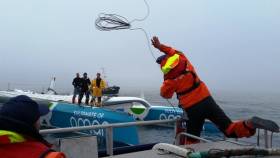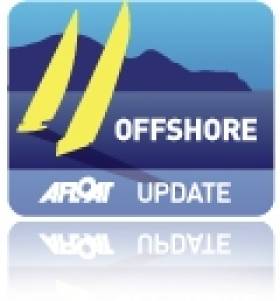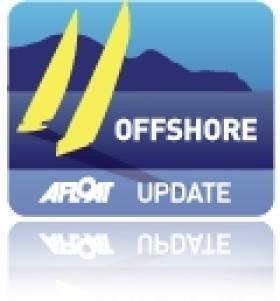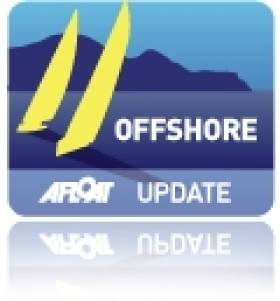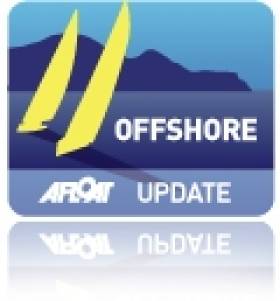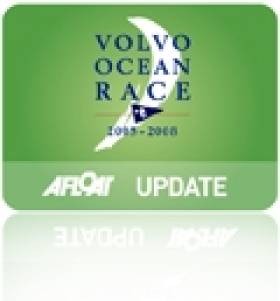Displaying items by tag: OMAN SAIL
Oman Sail Trimaran Successfully Recovered & Bound For France
Damian Foxall might be on course for yet a new record this morning off the West Coast of Ireland but the County Kerry Round the World sailor will spare a thought for his previous craft, the current record holder, the Oman Sail MOD70, Musandam-Oman Sail that is preparing for a tow back across the Atlantic Ocean for repairs.
The Arab MOD70 capsized off the Canadian Coast in July when a Transatlantic record attempt went wrong with Foxall on board. There's still no news on how the giant trimaran capsized.
The crew were rescued by a passing cargo ship and a giant recovery operation then followed. The crew, inlcuding Foxall, went back out into the Atlantic, found it five days later and recovered the broken rig boom and sails by diving. They righted the 70–foot hull mid–Atlantic, towed it back across Grand Banks to St Pierre et Miquelon where it is now lies. An Oman Sail spokeswoman told Afloat.ie: 'we are working on getting the boat back to France'.
#offshore – After a thrilling Round Ireland world record last week that saw the Sultanate of Oman's flagship MOD70 Musandam-Oman Sail break Steve Fossett's 22-year-old time around the Emerald Isle, French skipper Sidney Gavignet and his 50% Omani crew high-tailed it back to French waters to compete in the Tour de Belle Ile, finishing a respectable second to Gitana-Groupe Edmond de Rothschild.
"We were delighted with the Round Ireland record – with big seas and up to 40 knots, it was a huge challenge and another incredible achievement for Oman Sail," said Gavignet.
"We were also very happy to be able to make it back to France in time to race the Tour de Belle Ile, it meant that we could keep the intensity high which is a big part of my Omani crewmates training for 2015."
This was Musandam-Oman Sail's first Belle Ile and with 470 boats on the start line, it was quite a spectacle. Conditions were perfect for the multihull fleet with a steady 20 knots and a gentle ocean swell. "We had an excellent race against Gitana-Groupe Edmond de Rothschild and Paprec Recyclage and were happy to finish with a second," said Gavignet.
With just a few days rest between regattas, Musandam-Oman Sail's next event kicks off on Thursday at the ArMen Race sailed out of La Trinité-sur-Mer. The Sultanate's flagship will have a new skipper at the helm in Roland 'Bilou' Jourdain, a veteran of offshore racing and – amongst other victories – a two-time winner of the Route du Rhum. Bilou, as he is better known, will stand in for Sidney Gavignet for the rest of May while he steps on to the Chinese Volvo Ocean Race entry Dongfeng for the Leg from Newport to Lisbon. Alex Pella will also continue to sail on board the MOD70 lending great depth of experience.
"Bilou is the perfect fit for Oman Sail, he really understands the Omani sailor development programme and what we are trying to achieve and he knows the MOD70s well. Musandam-Oman Sail is in good hands," said Gavignet.
"For my part, I'm excited to be returning to an event that I really enjoy and to be doing the transatlantic leg with a team that has such great spirit. There are quite a lot of similarities between Dongfeng and Oman Sail in terms of the development of sailors – we met a few of the Chinese crew in February at EFG Sailing Arabia – The Tour which they were using as a training platform."
Roland Jourdain is excited at the prospect of sailing the MOD70, but is approaching the next few weeks as custodian conservatively: "I was lucky enough to sail with the team briefly for the Tour de Belle Ile, it was a good experience and a chance to get to know everyone. The atmosphere on board is very good and I have been well briefed on the objectives while Sidney is away – the main one being for everyone to continue learning. I was pleasantly surprised at the level and the teamwork amongst the crew
"You have to be constantly alert on the MOD70, it is a highly tuned beast, but the team already has excellent reactions so we will focus on reinforcing the fundamentals. It is going to be very interesting – I have been following Oman Sail for some time now and this national initiative is an excellent way of using sailing."
As for Fahad Al Hasni, the original MOD70 Omani sailor and an integral part of the offshore team, he is delighted to have the opportunity to learn from someone new: "We have worked hard on building a strong team and are seeing the results, we have made a lot of progress in the last couple of years. My Omani crewmates and I know the boat very well and are hungry for the challenges that are coming.
"I met Bilou on the European Tour and am familiar with his illustrious career, it will be an excellent opportunity for us to sail and race with him as he will look at us with fresh eyes compared to Sidney who knows us very well."
Post ArMen Race, the MOD70 will head to Kiel Week for the Welcome Race and an attempt on the boat's own record set in 2014. Before that happens though, the crew will race the team's M34 at Normandy Sailing Week (11-14 June). "And of course we will be supporting Sidney from afar during the next leg of the Volvo!" added Fahad.
#roundireland - The World Sailing Speed Record Council has ratified a new Round Ireland Outright World Record set by Sidney Gavignet (FRA) and a crew of 5 on the MOD70 trimaran Musandam-Oman Sail. They completed the 698nm route on May 4-6 in a time of 40:51:57, posting an average speed of 17.08 knots. The previous record of 44:42:20 set in 1993 was held by Steve Fossett on Lakota.
It May Be A New Round Ireland Record But The Three Hour Margin Tells Us What A Great Job Lakota Did 22 Years Ago
#roundirelandrecord – At his fourth attempt, top French skipper Sidney Gavignet with the Mod 70 trimaran Musandam-Oman Sail has finally toppled the long-standing Round Ireland record set in September 1993 by American Steve Fossett with the 60ft trimaran Lakota, but by only three hours.
And if anything, the Gavignet achievement has heightened just what a remarkable job was done 22 years ago when the American skipper with his smaller, heavier and much less technically advanced boat set such an exceptional time writes W M Nixon.
Unlike the state-sponsored Musandam-Oman campaign (and it's one very rich state), the Lakota project was very much a private enterprise effort, with Fossett's crew including husband-and-wife multi-hull enthusiasts Con Murphy and Cathy MacAleavey of the National YC in Dun Laoghaire. They had met the Lakota crew in Portugal some months earlier, and had persuaded them that a successful round Ireland challenge was just what was needed to set Fossett's sailing on the track to high achievement, and their suggestion succeeded brilliantly on both counts.
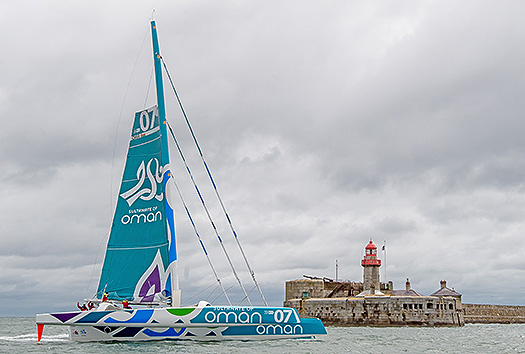
The new record holders – The mighty Mod70 returns to Dun Laoghaire this morning
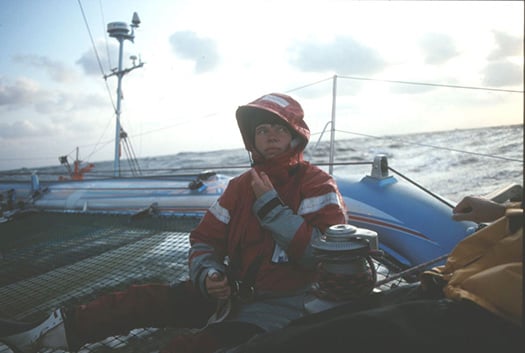
Cathy MacAleavey in some of the gentler conditions during Lakota's successful challenge

Getting there – when Lakota went past the Fastnet during her 1993 anti-clockwise circuit, they knew they were well on their way with the chance of an outstanding record.
Lakota's startling new time of 44 hours was not easily achieved, as the boat had arrived in Dun Laoghaire with a damaged mainsail which had to be rushed to Crosshaven for repairs by McWilliam Sailmakers while the clock was remorselessly ticking down towards the ideal situation of a vigorous low pressure area becoming centred over Ireland.
But as it happened, the Gods were on their side. The delay while waiting for the sail repair made the weather situation even better as far as records were concerned, and Lakota went round in style as regards speed, though for quite a lot of the passage she was sailing in conditions in which most people would have been very content to stay comfortably at home in front of a large fire.
And as the Lakota challenge included Irish crew and was Irish inspired, we all felt that we had a part of it, however small. But for this new record, the only Irish element has been the weather and our coastline, for although Gavignet's interest was first inspired some years ago by our own Damian Foxall who was involved in two of Gavignet's previous attempts on the Ireland challenge, the Kerryman is of course currently active in the Volvo World Race, and has had the frustration of watching from afar as Gavignet finally does the business.
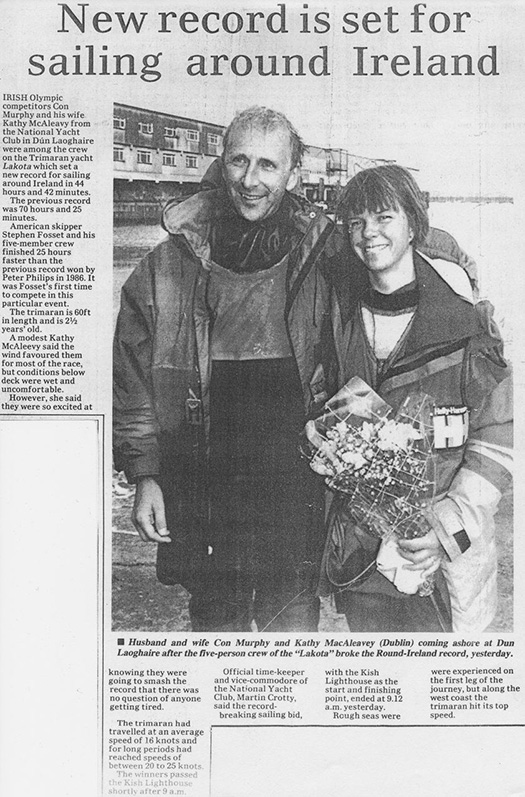
Tired but triumphant – Con and Cathy as pictured in the Evening Herald at the conclusion of Lakota's successful challenge
As it happens, although the monitoring of the challenge has been under Record Commissioner Chris Moore of the National Yacht Club, the crew is distinctly international, with two French – Gavignet himself and veteran Jean Baptiste Leavailliant, plus one Spanish, Alex Pella, and three Omanis who are now Gavignet veterans - Fahad Al Hasni, Yasser Al Rahbi, and Sami Al Shukaili.
The weather pattern was settling in nicely with strong sou'easters when they went off at 1800 hrs on Monday to storm northeastwards from the start point at the Kish L/H through the Irish Sea. But the current spell of volatile weather was making things decidedly moody over the north of Ireland. What had been a useful low pressure area of around 780 had already developed further to have two centres, and it may well have become the case that at least three different vortices were in action to provide unstable wind patterns of rapidly varying strengths, and sometimes no strength at all.
For the first stage, they'd been averaging speeds of up to 25 knots and better, and had confidently been anticipating knocking a cool ten hours off the record. That would have brought it in within the 35 hour working week so beloved of the French. But the fickle North Channel winds had other plans, and they unexpectedly dropped to just 6.32 knots SOG off Cushendall in County Antrim for a frustrating period around midnight on Monday.
Then they got going again along the North Coast, and were well back on track for a new record which, after all, required an average speed of only 16 knots. But one of the low pressure centres off the Donegal coast got itself all over the place through Tuesday afternoon, and progress was at times excruciatingly slow – at one stage northwest of Erris Head in far Mayo, they were crawling along at 3.11 knots, which for a MOD 70 is dead stopped.
The frustration was enormous, for they knew there were strong west to northwest winds on the way, and trying to get to them was the challenge. By Tuesday evening they were at last beginning to benefit, and then Musandam-Oman Sail fairly streaked south in very impressive style, zooming past the Blaskets and shaping her course with an ever-increasing eastern slant past the Skelligs and the Fastnet and along the south coast. She was tacking to lee at speeds which were hauling them rapidly back into the record business, but there was now no way they could make that elusive ten-hours-off-it target.
A least two high profile capsizes with MOD 70s – including on in Dublin Bay a couple of years ago – have shown that while they're able and versatile boats, they have their limits. So in tearing northwards along the east coast this morning in relatively smooth water with the wind off the land, care had to be taken that any sudden squalls off the mountains wouldn't take charge. But everything was kept firmly under control and the job was finished in businesslike style just before 11 o'clock this morning. And they're well pleased with their achievement, as it's a much clearer margin than the 16 minutes with which they bested Bank Populaire's Round Britain and Ireland record last year. So well done, Musandam-Oman Sail. And here's to the good old Lakota – she still sails the sea, a very special boat.
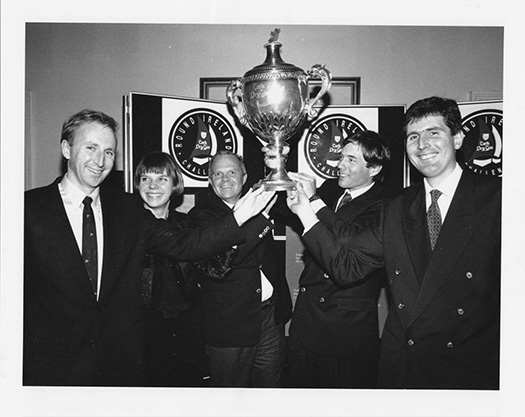
Victory! Lakota's crew with the trophy in 1993 are (left to right) Con Murphy, Cathy MacAleavey, the late Steve Fossett, Steve Scully, and Brian Thompson
#roundirelandspeedrecord – With arguably the hardest part of the 700–mile journey already over, the northabout Oman Sail Trimaran is 75–miles off the Sligo/Mayo coast and on target to break the Round Ireland Speed Sailing record of one day and 20 hours. Having covered 300 nautical miles in 19–hours, the fastest part of this voyage is yet to come.
The six man crew were heading in a southerly direction (190 degrees) just before noon, expecting to crack sheets and accelerate down the west coast in some forecasted big winds, ready to reach estimated speeds of over 30–knots before the Fastnet rock.
Round Ireland Record Update (0700): Gavignet Eyes Record Time As Trimaran Surfs off Donegal
#roundirelandrecord – The Sultanate of Oman's MOD70 Musandam-Oman Sail has rounded the top of Ireland and was hitting 20–knots off the coast of Donegal in a bid for the 20–year–old Round Ireland Speed sailling record early this morning. Having started on Dublin Bay last night at 1800 hours and headed north, the current ETA back on Dublin Bay is scheduled for tomorrow (Wednesday) morning which means the record could fall by as much as ten hours. At 0730, as the big French–based Tri passed Bloody Foreland, the international crew were steering 284 degrees and heading deep offshore.
French skipper Sidney Gavignet was reunited with his three Omani crew Fahad Al Hasni, Yasser Al Rahbi and Sami Al Shukaili who were key members of his triumphant team when Musandam-Oman Sail smashed the Round Britain and Ireland world record last August and now it looks like the 1993 Round Ieland record set by Steve Fossett on Lakota may now also be in doubt.
The National Yacht Club is the base for the record bid and Irish World speed Sailing Commissioner Chris Moore is officiating.
Also on board the Tri is Spanish sailor Alex Pella and the French multihull veteran Jean Baptiste Levaillant who have joined the Omani trimaran for the attempt to beat the long standing Round Ireland record of 44 hours set back in September 1993.
"The goal is to give my Omani crewmates some real life training in a range of conditions and we are taking advantage of an ideal weather window," explained Gavignet who was last on the boat when he raced it single-handed across the Atlantic in the Route du Rhum in November 2014.
The forecast before they threw the lines at 17:04 UTC on Monday was for light conditions that were scheduled to build significantly overnight. Before casting off, Sidney warned that they would be playing it safe: "We will be watching the weather carefully and avoiding risks."
Musandam-Oman Sail made an attempt on the Round Ireland record two years ago but were forced to abandon due to unsafe conditions but hopes are high that this time, the weather will be kinder and allow Oman Sail to add this speed record to their growing collection.
"The current record is held by great sailors, so it would be a huge source of pride for us to break it and add such an achievement to our experience as sailors. We are expecting a lot of challenges and very low temperatures to the north, but we are prepared and hope to return with another record for Oman," said Fahad Al Hasni.
"We are focussing this season on the sailor's strength and fitness, but also on preparing the boat and studying the weather to make them better all round offshore sailors. There won't be many record attempts on our schedule in 2015, but this one is a primary goal and if we can get the record, it would be very good for the guys, for the country and for Oman Sail," added Gavignet.
Since the boat was launched following a routine refit, Gavignet has been training with his crew in Lorient and taking part in the Grand Prix Guyader in Douarnenez in Brittany, France, where they flew the Omani flag in Europe for the first time this year and got back into competitive racing mode after a winter sailing with other crew in other boats.
Read more about the history of the Round Ireland Speed Sailing Record
#omansail – The Oman Sail Trimaran crossed the Dublin Bay start line and headed northabout just after 6pm this evening in its latest bid to break the twenty–year Round Ireland Speed Record held by the late American adventurer Steve Fossett. French skipper Sidney Gavignet at the helm of the 70–footer cleared the Kish lighthouse start line, flying a hull and producing a cloud of spray as one of the fastest boats in the world reached full speed. Gavignet must beat a 44–hour record and be back on Dublin Bay just after lunch on Wednesday.
Winds on Dublin bay were at 18–knots and gusting to over 25 this evening presenting ideal conditions for this professional crew. Onboard are Alex Pella from Spain and Jean Baptiste Levaillant together with three Omani sailors and skipper Gavignet.
The southerly direction of the Dublin Bay breeze produced lumpy, one metre waves, giving Irish World Speed Sailing Commissioner Chris Moore a difficult berth for officiating the record bid from the Dublin Bay Sailing Club starting vessel located just off the Burford bank.
Having arrived from France only this morning, Gavignet took only the briefest pitstop at the National Yacht Club in Dun Laoghaire Harbour before heading back out to sea for what amounts to his third attempt at the Round Ireland speed record in recent years. Gavignet tried to break the record previously in 2013 but was beaten back by strong winds in the Irish Sea. By starting this evening he has made good on a promise to return and make a record attempt.
With potentially only one night at sea, which must be helpful for record-breaking, the current forecast suggests there's just a chance of some nor'east before they get to the South Rock, and there's a chance also of a flat spot on Tuesday evening. But either way it's a good forecast for Oman who must average 16–knots to be in with a chance.
Last season, the trimaran crossed the finish line of the 2014 Sevenstar Round Britain and Ireland Race off the Royal Yacht Squadron in Cowes in August with an elapsed time of three days, 03 hours, 32 minutes, 36 seconds breaking the previous World Record for a multihull held by Banque Populaire 5 in 2011, by 16 minutes, 38 seconds.
Within minutes of crossing the line this evening, the 70–foot colourful vessel had cleared the capital's waters and disappeared into the mist of the Irish Sea. Her six man crew recognising there are over 700–miles between them and a record that has stood the test of time since 1993. In September 1993, Fossett, (sailing with Con Murphy, Cathy MacAleavey, David Scully and Brian Thompson) put the Kish astern again after 44 hours 42 minutes and 20 seconds an average of 15.84 knots. It's a record which has stood for over 19 years but wiill it still be standing on Wednesday? Sources close to the crew say they are confident of knocking up to ten hours off the record time and are expecting to be home by Wednesday morning.
New Attempt At Round Ireland Speed Sailing Record
#roundireland – Sidney Gavinet's Mod 70 Trimaran Oman Sail has set sail from France bound for Dun Laoghaire on his fourth attempt at smashing the Round Ireland speed sailing record.
The 70–foot tri is expected to be alongside the National Yacht Club on Monday, World Speed Sailing Irish Commissioner, Chris Moore has told Afloat.ie
In September 2013, Sidney Gavignet and Damian Foxall's Oman Sail cancelled their attempt when the weather forecast changed. It was the third time in 2013 that Kerry's Foxall and the team of Omansail ditched plans for an attempt on the speed sailing record. For a time it looked like an anti–clockwise bid might produce the required conditions to break the 44-hour time, coincidentally marking the 20th anniversary of the 1993 record set by Steve Fossett, Con Murphy and Cathy MacAleavey.
For this week's attempt, Foxall is not onboard the giant Tri. Instead Alex Pella from Spain and Jean Baptiste Levaillant, join three Omani sailors and skipper Gavinet.
Damian Foxall Set for 2013 Transat Jacques Vabre on Oman Sail
#TJV – Ahead of the Transat Jacques Vabre (TJV) in November, Oman Air-Musandam skippers Sidney Gavignet (FRA) and Damian Foxall (IRL) are leaving no stone unturned in their preparations to become the first MOD70 champions of the event.
Throughout the month of September, having qualified for the TJV by competing in the Rolex Fastnet Race in August, they have been putting their skills and temperaments to the test with a series of weather workshops, offshore challenges against MOD70 rivals and some heavy-duty training camps at the offshore training centre at Port La Foret in France.
They have been observed for compatible strengths and weaknesses and as a result, decided on a three-hour on three-hour off watch system that they believe will work well for them as they find a balance between pushing the boat hard and safe sailing.
"The most important thing about competing in a one-design boat is not only boat speed but avoiding mistakes in terms of breaking things or making bad manoeuvres and working out the best way to go," said Gavignet, who estimates the 5,450nms course from Le Havre to Itajaii in Brazil will take around 14 days.
"It is important that we understand the key moments of the race and when to push and when to ease up. We also need to understand energy management because bad decisions are mainly caused by fatigue so we have always to be aware of that.
"We have done a weather course with Jean-Yves Bernot – we did the same course before the Route des Princes which was very useful and makes us aware of the different scenarios so that we are prepared for them."
This is not the first time Gavignet and Foxall have competed together in a two handed transatlantic race (in 2008, they raced the Transat AG2R together, finishing in fifth place), but during the 2013 Route des Princes campaign in the summer and in subsequent training, they have identified a shared characteristic that they realise will require conscious moderating.
"In terms of skills, we have similar profiles but we both push the boat hard so we have to take it easy, keep a clear mind and slow down. Think more and act less. It is both a strength and a weakness," Gavignet said.
For Foxall, Ireland's most successful offshore sailor with two Volvo Ocean Race wins under his belt as well as his Barcelona World Race victory in 2007-08, the TJV is unfinished business after he was airlifted off Orma 60 trimaran Foncia when he and co-skipper Armel Le Cleach capsized.
That was eight years ago and although he is confident he and Gavignet can fend off challenges from the other two MOD70s Virbac-Paprec 70 and Edmond de Rothschild, he is under no illusion how difficult it will be.
"Of all the sailing I have done, this is without doubt the most demanding," he said.
"If you have too much sail area up on a multihull, it can be terminal and there are only two people to deal with it. Having said that, the boats require to be pushed and you push it much closer to 100% than you would if you were single-handed.
"It is very important at all times to be in control and always have one, if not two ways of depowering the boat.
"We'll push the boat hard but stay within the limits. Having too much sail area is not necessarily the fastest way to go forward."
Between now and the start of the TJV on Sunday 3 November, Gavignet and Foxall will continue their training sessions at Port la Foret with more test sailing before leaving for Le Havre around the 22 October.
Campaigning Oman Air-Musandam in the 2013 Route des Princes, Gavignet and Foxall were lucky to be part of a crew of six including Omani sailors Fahad Al Hasni and Ahmed Al Hasni but for the Transat Jacques Vabre, while Fahad will be supporting the crew with preparations and training sessions and observing to further his ability, he won't be racing this time.
"While I have learnt a lot already and am training as much as possible, it will take a few more years of experience for me to be ready for a two-handed race like this," said Fahad who will be on site in Le Havre for the start to support Sidney and Damian. "The MOD70 is a challenging boat and while I have learnt a huge amount sailing it crewed, and one day hope to race this event, for now I am supporting my team mates with their preparations."
The TJV starts from Le Havre on 3 November but to ensure all classes arrive in Brazil at around the same time, the MOD70s will start with the rest of the fleet but race just 40 miles in a prologue to decide the starting sequence when they start again on 8 November.
Coming up:
Training session in Port la Foret 23-26 September
#VOR - The Volvo Ocean Race team caught up with Ireland's own Damian Foxall on board Sidney Gavignet's MOF 70 yacht Oman Sail with fellow VOR veteran Neal McDonald.
As reported in March on Afloat.ie, Ireland's top offshore sailor - and watch-leader for last year's VOR-winning team Groupama - is part of an international crew that attempted to break the Round Ireland speed record that was unfortunately abandoned due to the harsh wintry conditions.
But Foxall vowed that a repeat attempt is on the cards, and tells the VOR website that his experience on Oman Sail "is exactly what I wanted to do after the Volvo. I just wanted to sail with a smaller team of friends, racing with a good crew."
He added: "Sidney, Neal and I have been sailing and working a lot together. It’s a very natural thing and it’s a pleasure.”
Foxall also sings the praises of the MOD 70 one design, heralding the future of the Volvo Ocean Race and the new VOR 65 yacht.
"It’s light in terms of logistics and repairs. On the water too, I’m looking forward to enjoy the best of the One Design sailing – the battle on the water and not in the boatyard."




























